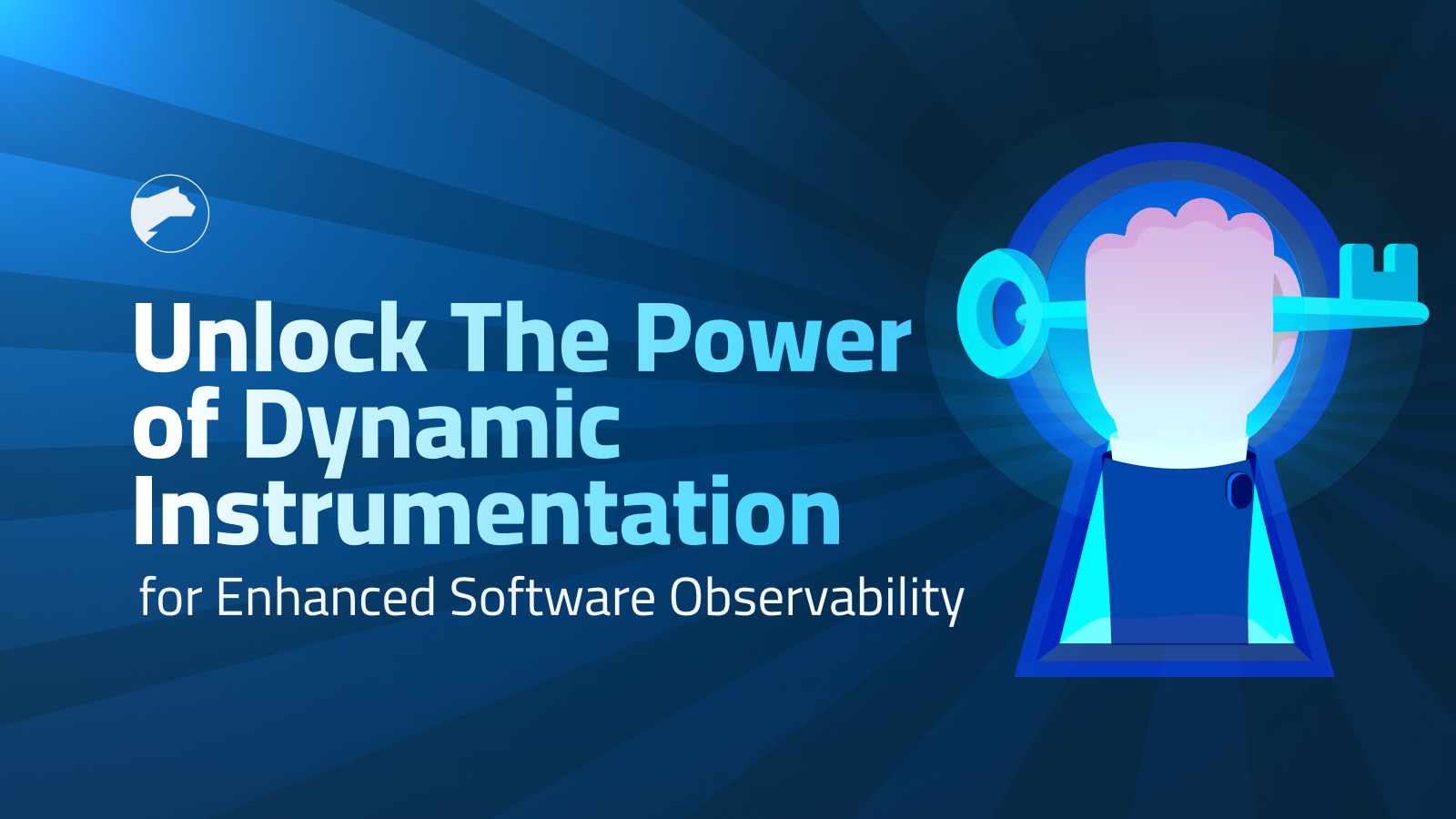

Unlock The Power of Dynamic Instrumentation for Enhanced Software Observability
In software development, dynamic instrumentation is a powerful linchpin between the development and debugging workflows. With software complexity reaching unprecedented levels, it is also a key enabler in boosting developer productivity in the pursuit of building performant and error-free software.
Let’s explore the concept of dynamic instrumentation and understand how it boosts software development processes with unparalleled insights into the source code.
What is Dynamic instrumentation?
Dynamic instrumentation refers to injecting logs into the software execution environment to capture metrics about the software’s runtime behavior or performance. The term dynamic instrumentation derives from the general definition of instrumentation, which refers to adding monitoring and measurement capabilities to a system. In the context of a software system, the monitoring capability is added to capture the internal state and variables during the software’s runtime execution.
The basic approach to achieving instrumentation is by embedding logs as specific lines in the source code to capture metrics. This is manual instrumentation. But, it is a laborious process and inefficient for a production environment. Automatic instrumentation solves this problem through spans, covering functions, and module scopes.However, it cannot capture metrics at a lower level within the runtime stack.
Dynamic instrumentation offers the advantage of capturing data at a granular level, which can also be configured during runtime execution. This data is a prerequisite for debugging since it helps developers perform root cause analysis (RCA) to unearth the leading cause behind a bug and identify the precise location in the source code responsible for that.
Therefore, instrumentation is essential for debugging, and the two terms are sometimes used interchangeably. However, there is a distinct differentiation in their goals. The primary goal of instrumentation is to gather data at runtime for monitoring, analysis, or performance optimization purposes. On the other hand, the primary goal of debugging is to use that data and combine it with other insights to identify and fix bugs in software. Dynamic instrumentation is the most efficient way of aiding in software debugging.
Evolution of Dynamic Instrumentation
The instrumentation of software applications is a familiar idea. Since the early days of enterprise software, developers have employed some means of monitoring and capturing metrics. Broadly speaking, it can be categorized into static and dynamic instrumentation.
Static instrumentation involves modifying the source code at specific lines before executing the software to inject code that captures logs and metrics. When the control flow passes through those source code lines during runtime, logs containing metrics about the runtime behavior or performance are emitted. It covers manual and automatic instrumentation techniques and requires developers to plan ahead and incorporate the instrumentation primitives within the source code during the development phase. Static instrumentation is best suited to debug software built with a monolithic architecture.
Static instrumentation does not scale well, considering today’s software architectures, which are distributed and highly granularized and fan out into many services with separate runtimes. Dynamic instrumentation helps solve this problem by allowing developers to simultaneously probe multiple runtime environments to emit logs and metrics at any point within the source code without modification, restarting, or redeploying the application. Dynamic instrumentation augurs well with live debugging, which allows developers to perform RCA to identify and pinpoint bugs in the production environment.
Advantages of Dynamic Instrumentation
#1: Metrics across different frames of abstraction
Modern software architectures are designed to offer a well-abstracted view of the software system across the tech stack. Typically, this view is split into infrastructure, service, and source code, with infrastructure being the highest level of abstraction.
Dynamic instrumentation offers developers and DevOps engineers a mechanism for probing software at different levels of abstraction to generate standardized or custom metrics. For example, at an infrastructure or service level, which represents a higher level of abstraction, the metrics are usually standardized, such as CPU utilization, network traffic, or API response times. At the source code level, which represents the lowest level of abstraction, developers want to capture custom metrics specific to the business logic being analyzed for fixing bugs.
| Lightrun is a developer observability platform offering some great features for dynamic instrumentation across the entire stack of a software system. It provides a unified view of the entire deployment, from code level, custom logs, to service level metrics and integrations with third-party infrastructure monitoring platforms. It bridges the gap between the different levels of abstraction for end-to-end debugging. |
#2: Shift left observability
In a landscape where software is deployed as a 24/7 service to assist mission-critical tasks, users’ expectations assume a great deal of importance. In such cases, a delay of a few seconds can be the difference between a great user experience and poorly performing software.
Dynamic instrumentation emerges as a potential savior, offering developers unparalleled insights into their code’s behavior. It can be leveraged as part of the shift-left philosophy to instrument the code right from the onset of the software development cycle, measuring critical performance metrics across the entire development cycle and deployment environments to monitor and fix performance issues impacting end-user experience before the code gets into production.
#3: Enhanced debugging support
Dynamic instrumentation is a key enabler for live debugging. Debugging is one of those intricate tasks that can often cause developers to lose the context of code. This is especially true if they frequently switch between the development and production environments while debugging critical bugs.
Dynamic instrumentation allows developers to inject code level metrics within the runtime execution context. As a result, developers can perform live debugging in the production environment without worrying about losing the context of the actual scenario that caused the bug, especially while debugging those hard-to-find issues involving data races and deadlocks.
#4: Alignment with business metrics
Incorporating dynamic instrumentation in a software development project offers an edge in the overall business metrics. From a productivity standpoint, it improves the DORA metrics. More specifically, one such metric is the MTTR (Mean Time to Resolve), which measures the average time to resolve a problem. Dynamic instrumentation helps in the early detection of bugs through developer observability, reducing the time it takes to perform the RCA on a problem.
Although DORA metrics are associated with developer productivity and operational efficiency, they directly correlate with some second-order business performance metrics, which also stand to gain from dynamic instrumentation. Some of the core business-level metrics include Time To Market (TTM) and Net Promoter Score (NPS).
TTM is the time it takes from a new feature’s conception until it is deployed in production. Following the shift-left methodology, dynamic instrumentation allows real-time feedback during feature development iterations to resolve issues early in the development cycle and avoid delays. Similarly, NPS represents customer satisfaction. This is a measure of the degree to which customers are happy with getting their issues resolved after reporting bugs in the software. Dynamic instrumentation allows developers to query the production system and address customer concerns without getting bogged down by the operational challenges of DevOps and platform dependencies for recreating the debugging scenarios.
#5: Truly observable software
Observability is the hallmark of modern cloud-native software. It ensures that developers can peek into the software system’s innards and access the state, stack, and specifics of the runtime context. Observability relies on collecting data and metrics, and dynamic instrumentation is the way to achieve that without disrupting the runtime execution. This is crucial for maintaining vigilance in production environments. It allows continuous monitoring and troubleshooting without affecting system availability or user experience.
Final Thoughts: The Transformative Impact of Dynamic Instrumentation
Dynamic instrumentation is not a tool but a catalyst for continuous improvement and innovation in software development. It embraces the next generation of software architecture and deployment patterns, aligns with agile methodologies for extreme programming, and empowers teams to detect and resolve issues swiftly.
As businesses strive to stay competitive in an increasingly fast-paced digital landscape, embracing dynamic instrumentation leads to improved operational efficiency, faster time to market, and superior customer satisfaction.
Book a demo of the Lightrun platform and start leveraging dynamic instrumentation to capture logs, snapshots, and metrics in your source code.
For more details, check out the documentation for superfast developer onboarding.
It’s Really not that Complicated.
You can actually understand what’s going on inside your live applications.




